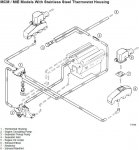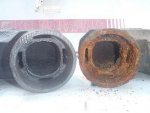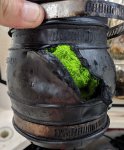amitchell01
Cadet
- Joined
- Dec 30, 2018
- Messages
- 8
Hi everyone.
Out today for the first trip in my new for me 1999 Bayliner 2855 with a pre-MPI mercruiser 7.4 and generation 1 bravo 3 leg.
About 45 minutes into the trip, while engine temps (according to the gauge) never went above normal, I noticed a strong burning rubber smell. I stopped the boat and had a plume of smoke come up from around the engine cover. On opening the engine cover (with a friend at the ready with a fire extinguisher) I noticed that the starboard side exhaust riser was extremely hot (to the point where it has melted the paint on the riser) and the lower rubber boot (below the elbow) was almost totally burnt away. Smoke was pouring from this. (The rubber fitting between the riser and the elbow was strangely unaffected) There was so much water pouring in through the non almost non-existent rubber fitting that the bilge pump could't keep pace so I started bailing while a passing boat towed me to a nearby beach. The port side riser and manifold appeared to be completely normal temperatures.
These are brand new risers, fitted by the previous owner just prior to me purchasing the boat. (The boat was run for 3 months with these risers before being pulled out of the water for sale) The boat also came with new manifolds in boxes - unfitted as yet as the previous owner had ordered them but they arrived a day after I bought the boat.
It's up on dry land now but I'm a newby to mercruiser I/O so I'm a little unsure of where to start. I obviously need to replace the rubber fitting but does anyone have any pointers for what I should be checking in terms of what caused the riser to overheat in the first place? Anything else I should be checking? (I ended up with about a foot of salt water in the transom)
Any help or advice would be appreciated.
Out today for the first trip in my new for me 1999 Bayliner 2855 with a pre-MPI mercruiser 7.4 and generation 1 bravo 3 leg.
About 45 minutes into the trip, while engine temps (according to the gauge) never went above normal, I noticed a strong burning rubber smell. I stopped the boat and had a plume of smoke come up from around the engine cover. On opening the engine cover (with a friend at the ready with a fire extinguisher) I noticed that the starboard side exhaust riser was extremely hot (to the point where it has melted the paint on the riser) and the lower rubber boot (below the elbow) was almost totally burnt away. Smoke was pouring from this. (The rubber fitting between the riser and the elbow was strangely unaffected) There was so much water pouring in through the non almost non-existent rubber fitting that the bilge pump could't keep pace so I started bailing while a passing boat towed me to a nearby beach. The port side riser and manifold appeared to be completely normal temperatures.
These are brand new risers, fitted by the previous owner just prior to me purchasing the boat. (The boat was run for 3 months with these risers before being pulled out of the water for sale) The boat also came with new manifolds in boxes - unfitted as yet as the previous owner had ordered them but they arrived a day after I bought the boat.
It's up on dry land now but I'm a newby to mercruiser I/O so I'm a little unsure of where to start. I obviously need to replace the rubber fitting but does anyone have any pointers for what I should be checking in terms of what caused the riser to overheat in the first place? Anything else I should be checking? (I ended up with about a foot of salt water in the transom)
Any help or advice would be appreciated.
Last edited:























